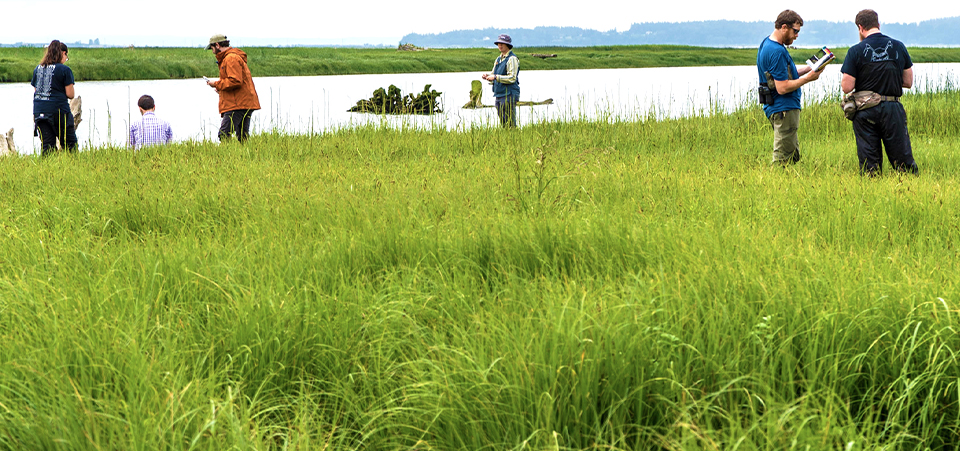Environmental Conservation
Environmental Conservation
Environmental Conservation

Applying to the Program
Program Briefing Sessions for Fall Entry now Live:
The Bachelor of Applied Science in Environmental Conservation began in 2014; our Fall 2024 cohort will have 24 seats.
Accepted participants are required to attend a program onboarding.
Participants will also be required to meet all conditions of acceptance identified in the program acceptance letter prior to the start of the Fall 2024 quarter.
Skagit Valley College Bachelor of Applied Science in Environmental Conservation Application Steps
Register for and Attend a program briefing
Choose a program briefing that fits with your schedule and register. At these faculty-led events, you will hear a program overview, including a discussion of its unique learning mode and entry requirements, and receive program application information.
You must attend a program briefing to receive application materials..
Program Prerequisites
By the time of entry into the program, you must have:
- Attended a BASEC program briefing session. This is the only way a prospective student can receive an application.
- An associate degree (AA, AAS-T, AAS, or ATA) in Environmental Conservation or Biology by the time of entry into the program with a cumulative GPA of 2.50 or 90 credits of equivalent college-level courses. The equivalent courses must include at least 15 credits spread among at least two of the following areas Biology, Ecology, Wildlife Management, Natural Resource Management, Fisheries, Environmental Science, Forestry Rangeland Management, Entomology, Watershed Requirements.*
- Met the entry requirements for ENVC 304 (first quarter course)
-
- ENGL 101 and ENGL 102 or 10 credits equivalent college level English with a grade of C or higher.
- CMST 220 or equivalent with a grade of C or higher.
- CHEM 121 or other lab Chemistry with a grade of C or higher.
- MATH 141 or MATH 146 or equivalent with a grade of C or higher.
- GIS 101 or equivalent with a grade of C or higher.
Submit an Application for the Bachelor in Environmental Conservation Program
Use the link in the email sent to you.
The application link email will be sent to the same email address you used for the program briefing session.
The application requires you to share a brief professional statement. The statement prompts, and the rubric are available below.
Professional Statement
Your faculty are curious about your experiences with independent learning. They also want to know more about why you are interested in this bachelor’s program and how this degree will support your aspirations.
These areas are the topics of the SVC Bachelor in Environmental Conservation professional statement.
The final statement essay should be between 800-900 words, which is about two single-spaced pages.
As bachelor’s degree, staff are not able to review drafts of your essay, we encourage those currently enrolled at SVC to consult the Writing Center for help. Your associate degree advisor may also be a great resource with this application.
This professional statement is an important part of your application; we encourage you to give it your best effort.
Directions
Part A.
Describe an experience where you learned something independently.
- Explain what you learned (the topic, the skills), how you went about learning (tools, techniques, resources you drew on) and what made it an independent learning experience.
- Share what you enjoyed and did not enjoy about the experience, including the reasons why and how you navigated obstacles that came up (if not obstacles came up, explain why).
- Based on this experience, what is one thing you would do differently in an independent learning experience again? Why did you choose this “redo”? If you would do nothing differently, explain why.
Part B.
Describe your professional interests and background and share your career aspirations from a short-term (five years) and a longer-term (more than ten years) perspective.
- Focus on how a bachelor’s degree will help you achieve your professional goals. If you have not yet identified definitive career aspirations, say so and share your ideas on career paths you would like to explore.
2. Create a response that is between 800-900 words (two single-spaced pages).
3. Submit your response with your application as a word document attachment. Applications without essays will be excluded from the review process.
Evaluation
| Advanced | Complete / Proficient | Getting There | Unacceptable / Missing | |
|---|---|---|---|---|
| Response to Essay Prompts |
|
|
|
|
| Clarity of Response |
|
|
|
|

